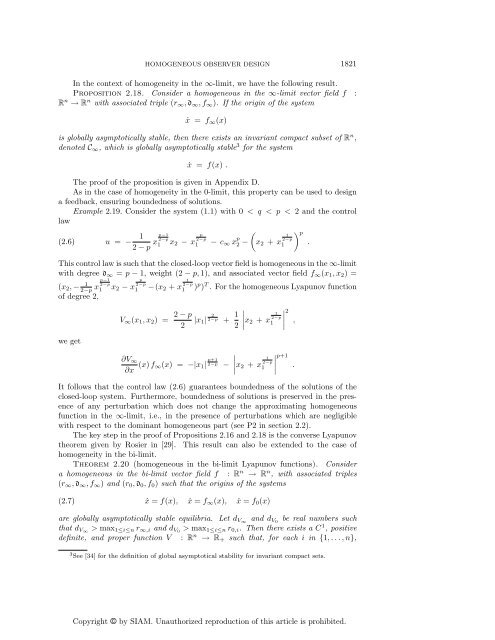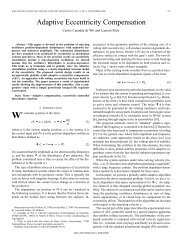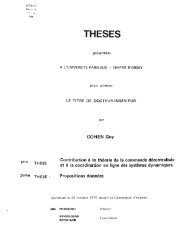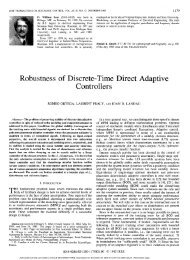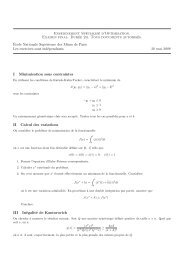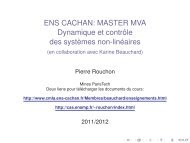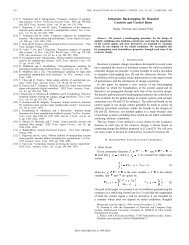Copyright © by SIAM. Unauthorized reproduction of this article is ...
Copyright © by SIAM. Unauthorized reproduction of this article is ...
Copyright © by SIAM. Unauthorized reproduction of this article is ...
Create successful ePaper yourself
Turn your PDF publications into a flip-book with our unique Google optimized e-Paper software.
HOMOGENEOUS OBSERVER DESIGN 1821In the context <strong>of</strong> homogeneity in the ∞-limit, we have the following result.Proposition 2.18. Consider a homogeneous in the ∞-limit vector field f :R n → R n with associated triple (r ∞ , d ∞ ,f ∞ ). If the origin <strong>of</strong> the systemẋ = f ∞ (x)<strong>is</strong> globally asymptotically stable, then there ex<strong>is</strong>ts an invariant compact subset <strong>of</strong> R n ,denoted C ∞ , which <strong>is</strong> globally asymptotically stable 3 for the systemẋ = f(x) .The pro<strong>of</strong> <strong>of</strong> the proposition <strong>is</strong> given in Appendix D.As in the case <strong>of</strong> homogeneity in the 0-limit, <strong>th<strong>is</strong></strong> property can be used to designa feedback, ensuring boundedness <strong>of</strong> solutions.Example 2.19. Consider the system (1.1) with 0 < q < p < 2 and the controllaw(2.6) u = − 1(2 − p x p−12−p1 x 2 − x p2−p1 − c ∞ x p 2 −x 2 + x 12−p1) p.Th<strong>is</strong> control law <strong>is</strong> such that the closed-loop vector field <strong>is</strong> homogeneous in the ∞-limitwith degree d ∞ = p − 1, weight (2 − p, 1), and associated vector field f ∞ (x 1 ,x 2 )=(x 2 , − 12−p x p−12−p1 x 2 − x p2−p1 −(x 2 + x 12−p1 ) p ) T . For the homogeneous Lyapunov function<strong>of</strong> degree 2,V ∞ (x 1 ,x 2 ) = 2 − p2 1|x 1 |2−p + 22 ∣ x 2 + x 12−p1 ∣2,we get∂V ∣ ∣∣∣ ∞∂x (x) f ∞(x) = −|x 1 | p+12−p − x 2 + x 112−p∣p+1.It follows that the control law (2.6) guarantees boundedness <strong>of</strong> the solutions <strong>of</strong> theclosed-loop system. Furthermore, boundedness <strong>of</strong> solutions <strong>is</strong> preserved in the presence<strong>of</strong> any perturbation which does not change the approximating homogeneousfunction in the ∞-limit, i.e., in the presence <strong>of</strong> perturbations which are negligiblewith respect to the dominant homogeneous part (see P2 in section 2.2).The key step in the pro<strong>of</strong> <strong>of</strong> Propositions 2.16 and 2.18 <strong>is</strong> the converse Lyapunovtheorem given <strong>by</strong> Rosier in [29]. Th<strong>is</strong> result can also be extended to the case <strong>of</strong>homogeneity in the bi-limit.Theorem 2.20 (homogeneous in the bi-limit Lyapunov functions). Considera homogeneous in the bi-limit vector field f : R n → R n , with associated triples(r ∞ , d ∞ ,f ∞ ) and (r 0 , d 0 ,f 0 ) such that the origins <strong>of</strong> the systems(2.7) ẋ = f(x), ẋ = f ∞ (x), ẋ = f 0 (x)are globally asymptotically stable equilibria. Let d V∞ and d V0 be real numbers suchthat d V∞ > max 1≤i≤n r ∞,i and d V0 > max 1≤i≤n r 0,i . Then there ex<strong>is</strong>ts a C 1 , positivedefinite, and proper function V : R n → R + such that, for each i in {1,...,n},3 See [34] for the definition <strong>of</strong> global asymptotical stability for invariant compact sets.<strong>Copyright</strong> © <strong>by</strong> <strong>SIAM</strong>. <strong>Unauthorized</strong> <strong>reproduction</strong> <strong>of</strong> <strong>th<strong>is</strong></strong> <strong>article</strong> <strong>is</strong> prohibited.


